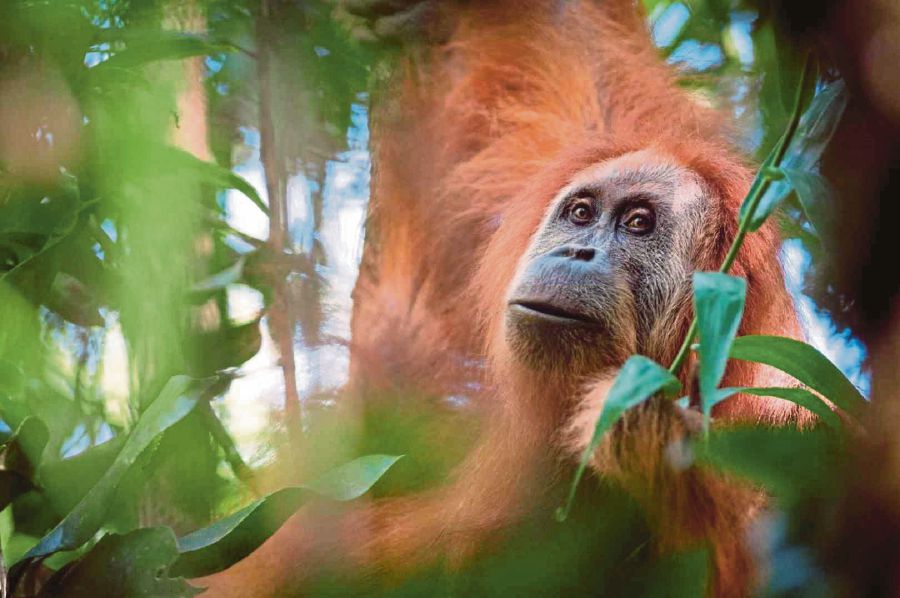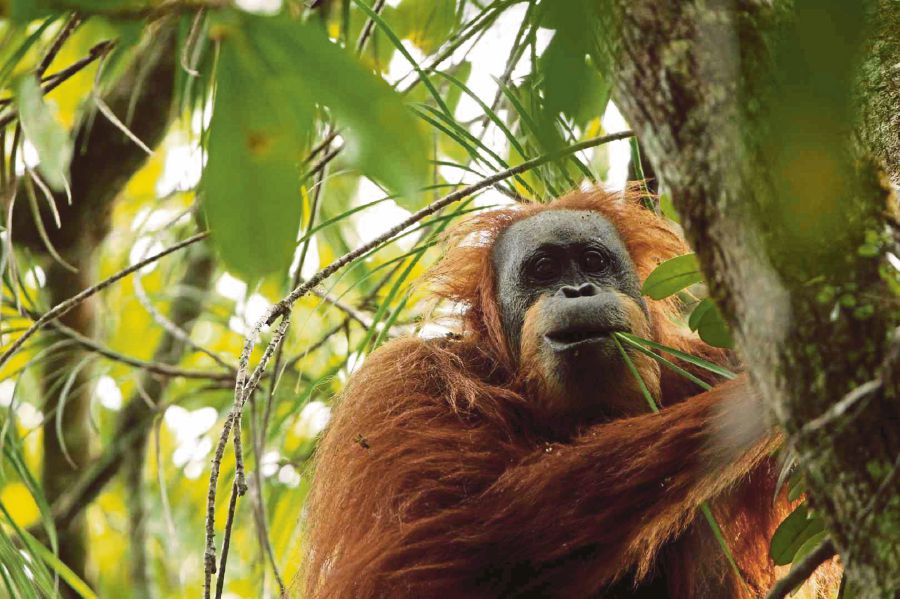There are fewer than 800 individuals of the newfound Batang Toru orangutan species left in the wild.
Credit: Maxime Aliaga
An isolated group of orangutans hiding out in a forest in Sumatra is now considered an entirely new species and the world's most endangered great ape, researchers say.
Until now, scientists had long recognized six species of living great apes(not including humans): Sumatran orangutans, Bornean orangutans, eastern gorillas, western gorillas, chimpanzees and bonobos. So, to describe a new great-ape species is rare, the researchers said. Fewer than 800 individuals of the newfound species, called Pongo tapanuliensis, survive in the Batang Toru forest.
"It isn't an everyday event that we find a new species of great ape, so indeed the discovery is very exciting," senior study author Michael Krutzen, a professor of evolutionary anthropology and genomics in the Department of Anthropology at the University of Zurich in Switzerland, said in a statement. [In Photos: Adorable Orangutan Shows Off Knot-Tying Skills]
Scientists didn't even know about this population, which lives south of what was thought to be the southern range of Sumatran orangutans, until 1997. After that, research had suggested this group had behavioral and genetic differences from other orangutan groups. But until now, scientists couldn't say for certain that these differences supported a new species designation, they said.
That changed in November 2013, when an adult male orangutan from Batang Toru died due to wounds sustained by local villagers. That event gave the researchers access to study material, and a careful examination revealed differences in the skull and teeth compared with other orangutans, they said.
The researchers found differences in features of the skull of Pongo tapanuliensis (shown here) compared with that of other orangutan species.
Credit: Nater et al./Current Biology
The researchers also studied the genomes of 37 orangutans, including P.tapanuliensis, and found that about 3.4 million years ago, the Batang Toru population and Bornean orangutans to the north of Lake Toba, in northern Sumatra, split to become separate species.Then, no more than 700,000 years ago, the Bornean and Sumatran orangutans diverged into separate species, the researchers said.
Their analysis and models describe a scenario in which orangutans from mainland Asia first entered a region called Sundaland, in southeastern Asia south of what is now Lake Toba. The lake formed in the caldera of the supervolcano Mount Toba, which was responsible for the largest eruption on Earth in the past 2.5 million years. Then, this ancestral population — of which P. tapanuliensis is a direct descendant — would have subsequently moved into what is now Borneo, Java and northern Sumatra.
"The Batang Toru orangutans appear to be direct descendants of the initial orangutans that had migrated from mainland Asia, and thus constitute the oldest evolutionary line within the genus Pongo," study researcher Alexander Nater, now at the University of Konstanz in Germany, said in the statement. "The Batang Toru population was connected to populations to the north until 10,000 or 20,000 years ago, after which it became isolated."
Currently, the survival of the Batang Toru orangutans is threatened by activities such as illegal road construction, killings during human-orangutan conflicts (over crops) and illegal trade of the animals, the researchers wrote in their paper, which was published online yesterday (Nov. 2) in the journal Current Biology. Perhaps an even more imminent threat, however, is the proposed development of a hydroelectric dam on Sumatra that could impact up to 8 percent of the Batang Toru population, the researchers said.
"To ensure long-term survival of P. tapanuliensis, conservation measures need to be implemented swiftly," they wrote.
KOTA KINABALU: Researchers have discovered a new species of orangutan in North Sumatra, Indonesia, prompting conservationists to call for urgent protection of the species.
The species Pongo tapanuliensis, also known as the Tapanuli orangutan, was found in the three Tapanuli districts of North Sumatra after close analysis of primate inhabitants of the Batang Toru ecosystem.
The discovery was made by collaborative research from an international team, including researchers from the School of Biosciences at Cardiff University.
Cardiff University reader Benoit Goossens said the Batang Toru populations of orangutans in Sumatra were only rediscovered in 1997.
“It was not until 2013 that the researchers received the skeleton of an adult male orangutan that was killed during conflict, and we realised that there were significant physical and genetic differences in these apes.

The Batang Toru orangutan population was potentially unique, which prompted the international team of researchers to work together to gather further evidence. PIC BY DANAU GIRANG FIELD CENTRE
“By comparing the skull to other orangutans, it was clear that this skull showed dramatic differences. It is crucial that we work to conserve the forest, because if we do not take the steps needed to protect the Tapanuli orangutans, we could see their discovery and extinction within our lifetime,” said Goossens, who was also the director of Danau Girang Field centre.
He said the finding suggested that the Batang Toru orangutan population was potentially unique, which prompted the international team of researchers to work together to gather further evidence.
The team, which is led by Professor Michael Krützen from University of Zürich, is made up of members of the Sumatran Orangutan Conservation Programme, Indonesian authorities, the Australian National University, Cardiff University and many other institutions.
Meanwhile, Krützen said when they realised the Batang Toru orangutans were morphologically different from all other orangutans, the pieces of the puzzle fell into place.
“The oldest evolutionary line in the genus Pongo is actually found in Batang Toru orangutans, which appear to be direct descendants of the first Sumatran population in the Sunda archipelago.
“Computer modelling reconstructed the population history of the three orangutan species, revealing that the Batang Toru apes have been isolated for 10,000 to 20,000 years.”

With no more than 800 individuals, the new species of orangutan is now considered the most endangered species of great apes on the planet. PIC BY DANAU GIRANG FIELD CENTRE
Another lecturer from Cardiff University Pablo Orozco-ter Wengel said the divergence between the Tapanuli orangutans and the other two orangutan species came as a surprise.
“It pushed the divergence between these species to as far as three million years ago, with the south of Toba orangutans being more similar to the Bornean orangutans, than to the north of Toba orangutans.”
“It’s exciting to describe a new great ape species in the 21st century... however, with such low numbers of the Batang Toru orangutans, it is vital that we now work to protect them. Mining, hunting, deforestation and human encroachment all risk the lives of these great apes.”
With no more than 800 individuals, the new species of orangutan is now considered the most endangered species of great apes on the planet.




0 comments: